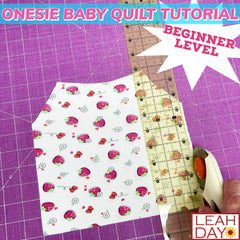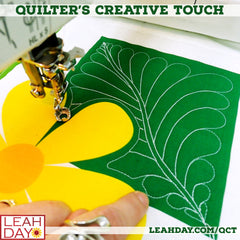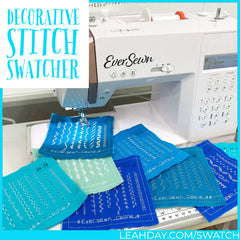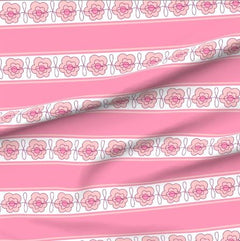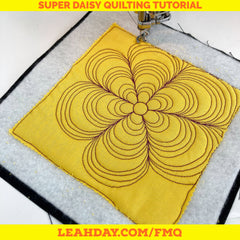![]() Picking a good batting for your quilt is one of the most important decisions you will make during the construction process. The batting is the middle layer of your quilt, and never seen on the surface. However, your finished quilt's appearance, drape, softness, and comfort are all directly related to the batting you basted in the middle.
Picking a good batting for your quilt is one of the most important decisions you will make during the construction process. The batting is the middle layer of your quilt, and never seen on the surface. However, your finished quilt's appearance, drape, softness, and comfort are all directly related to the batting you basted in the middle.
When you're just starting out in quilting, it can be very hard on your budget to have invested in all the tools and supplies you need, fabric for your first quilt, and then spend even more money for your batting.
Because of this, many quilters (and me included!) will choose to skimp on batting.
Here's my cheap batting confession:
When I first began quilting, I used a super cheap $7 batting from Wal-mart. It was 100% cotton and produced a slightly crinkled, wrinkly effect on the quilt surface after washing, which was a nice effect for the soft bed quilts I was making at the time.
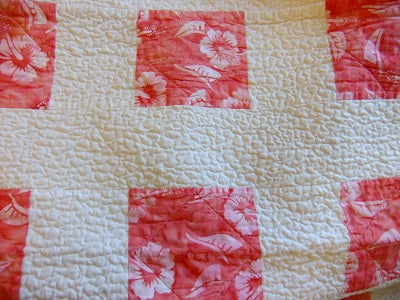
Unfortunately Wal-mart decided to stop carrying this batting and I suddenly had to face the unknown. Which batting is good? How much will I need to spend? What is the difference between all the different fabric choices?
Exploring Your Batting Choices
 I'd become dependent upon that single cheap batting and suddenly I had to start experimenting and trying different battings in different lofts and fibers. Yes, this was scary and frustrating at times, but it was also thrilling to see how different my quilts looked and felt when I used a different batting in the middle.
I'd become dependent upon that single cheap batting and suddenly I had to start experimenting and trying different battings in different lofts and fibers. Yes, this was scary and frustrating at times, but it was also thrilling to see how different my quilts looked and felt when I used a different batting in the middle.
There's no real way of knowing a batting is "good" or "bad" except to try it out for yourself. You need to see how the batting behaves and decide for yourself what you'd like to see in your quilts. Developing your own opinions is one of the most crucial steps to becoming a happy quilter.
For example, there might be a batting that I absolutely love, but you will hate because it smells funny to you. See? The only way to know what works is to try it!
Batting Fiber Choices
There are so many amazing fiber choices when it comes to batting. Many companies are now offering cotton, polyester, wool, bamboo, and many blends of these materials as well. These different fibers all have unique characteristics that will effect the appearance and feel of your finished quilt. Here are just a few fiber choices you may want to try:
Cotton - Cotton is a natural choice for many quilters because we're already working with cotton fabric. However, cotton will always have a tendency to shrink within your quilt, which produces a soft, crinkly effect on the surface. This is terrific for bed quilts, but probably not the best choice for wall hangings where you want the quilting stitches and design to shine.
 Polyester - This man made material has virtually no shrink and produces quilts that can hang stunningly straight on a wall. This batting is also extremely stable and a perfect choice for special quilting techniques like trapunto that depend on the batting holding it's shape perfectly.
Polyester - This man made material has virtually no shrink and produces quilts that can hang stunningly straight on a wall. This batting is also extremely stable and a perfect choice for special quilting techniques like trapunto that depend on the batting holding it's shape perfectly.
Wool - Super warm and soft, wool is a great choice for winter bed quilts. This special fiber is unique in that it holds no memory so your quilts will never get fold lines and creases, even when folded up tightly for months. For this reason, wool is a very popular show quilt batting.
Bamboo - Bamboo is a wonderful batting type from an abundant resource. These battings tend to have a bit of shrinkage, but a very soft hand and lightweight feel. They're a great choice for summer time bed quilts and lightweight throw quilts.
How to Test Your Quilt Batting
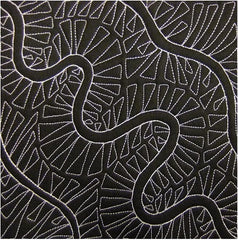 Cut a 15 - 20 inch square of batting, sandwich it with cotton fabric on the top and bottom, and quilt it in a similar style to your next quilt. Just in case you're searching for inspiration you can find 30 easy designs to try in the workshop Beginner Free Motion Quilting Fillers!
Cut a 15 - 20 inch square of batting, sandwich it with cotton fabric on the top and bottom, and quilt it in a similar style to your next quilt. Just in case you're searching for inspiration you can find 30 easy designs to try in the workshop Beginner Free Motion Quilting Fillers!
Bind the edges of your mini quilt, then throw it in the washer. Treat this little sample exactly the same way you would a real quilt. You won't know how the batting will look and feel within your quilt until you run it through this test to see how it reacts to quilting and washing.
You'll want to keep your eyes peeled for any signs of migrating or bearding. Bearding often happens with cheap battings because they tend to break down and begin pushing out of the quilt through the needle holes in the quilting.
Migrating is also caused by a batting breaking down and not holding it's shape within the quilt. Larger spaces left unquilted may shift and become lumpy if the batting isn't good quality.
Batting Determines Your Quilting
The most important key to picking your batting is understanding how much this one choice will effect your quilting. Each batting comes with a rating - a suggestion for how close your lines of quilting should be so the batting doesn't shift within the quilt.

This batting recommends quilting up to 3 1/2 inches apart. This means your lines of quilting should be between 2-3 inches apart to prevent the batting from shifting.
As you can see, this will greatly affect how much quilting you're required to put on a particular quilt. In order to hold the layers together securely, you will need to be sure not to leave any space open larger than this rating describes.
If you have a quilt that needs to be finished quickly, make sure to check the rating on the batting to see just how densely you will need to quilt your quilt. The bigger this number is, the less quilting you will have to do, and the faster your quilt will be to finish!


